When it comes to Amateur Radio, things that I think I’m building or installing for temporary use sometimes end up becoming a permanent fixture of my station. What was intended as a “kludge” gets used longer than it should have.
This was the case for the rope-and-pulley system that supported my first HF antenna, an 80 m off-center-fed (OCF) wire dipole, which I put up in the trees not quite 8 years ago. (The OCF dipole was replaced a few years later by a center-fed 80 m dipole, also suspended by the same rigging and still in use as of this writing.)
Illegal Choke Hold
I had installed the 80 m OCF, and later the center-fed, in an inverted vee, with its feedpoint at a height of 50 ft, and the ends about 20 ft high. The feedpoint was supported by a long rope that ran through pulleys in two trees, one on either side of the dipole. I had climbed the trees to install each pulley about 53 ft high.
At the time, fastening a pulley with a loop of rope tied around the trunk seemed like the strongest, cheapest, and easiest approach to secure it to the tree. I left about 6 inches of slack in the rope, giving little thought to what would happen as the trunk grew. Like any new ham, I just wanted to get the antenna up and get on the air.
Fast-forward seven and a half years. Here is one of those pulleys as I found it, just prior to removing and re-attaching it.
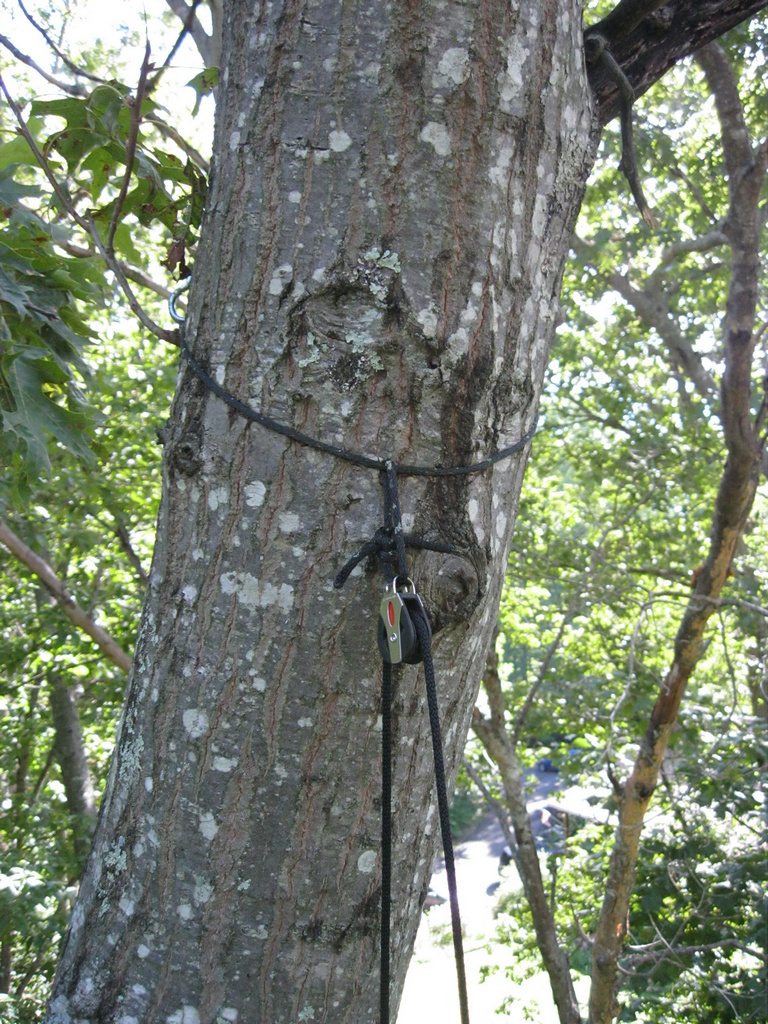
I had seen from ground level that the original slack had been completely taken up by the growth of the trunk and the rope loop was now choking or “girdling” the tree. Girdling poses a risk of damaging the tree by constraining the live tissue just under the bark. This is the vital part of the tree that transports nutrients and water.
In this case, there was also a risk of the rope breaking under the extreme tensile force imposed by the trunk as it expands — slowly but mightily.
I wanted to continue using this rigging to hold up my antenna, and felt it was worth some effort to keep this tree as sound as possible going forward. So I climbed the tree.

I Only Have Lag Screw Eyes for You
Once in the tree canopy, I found the rope loop taught as a banjo string (see figure 1 above). It sprung forcefully off the trunk when I cut it. I had brought up a new pulley, but found the original one (Ronstan part no. HRF30101) in good condition. I re-attached the pulley with what I now consider a more durable and tree-friendly method for the long term, using a lag screw eye.

This particular screw eye (part no. 30455T63 at McMaster-Carr) is stainless steel with a 2-3/4 inch shank length and 5/16 inch diameter. Before climbing I confirmed that the stainless steel quick link I planned to use would fit through the screw eye and pulley. I used a cordless drill to bore a pilot hole for the screw. Once the new hardware was in place, I snugged the quick link shut with a wrench.
A lag screw eye of this size is strong, and sunk at least two inches into sound wood, it is very unlikely to pull out under the forces involved in supporting a wire antenna.
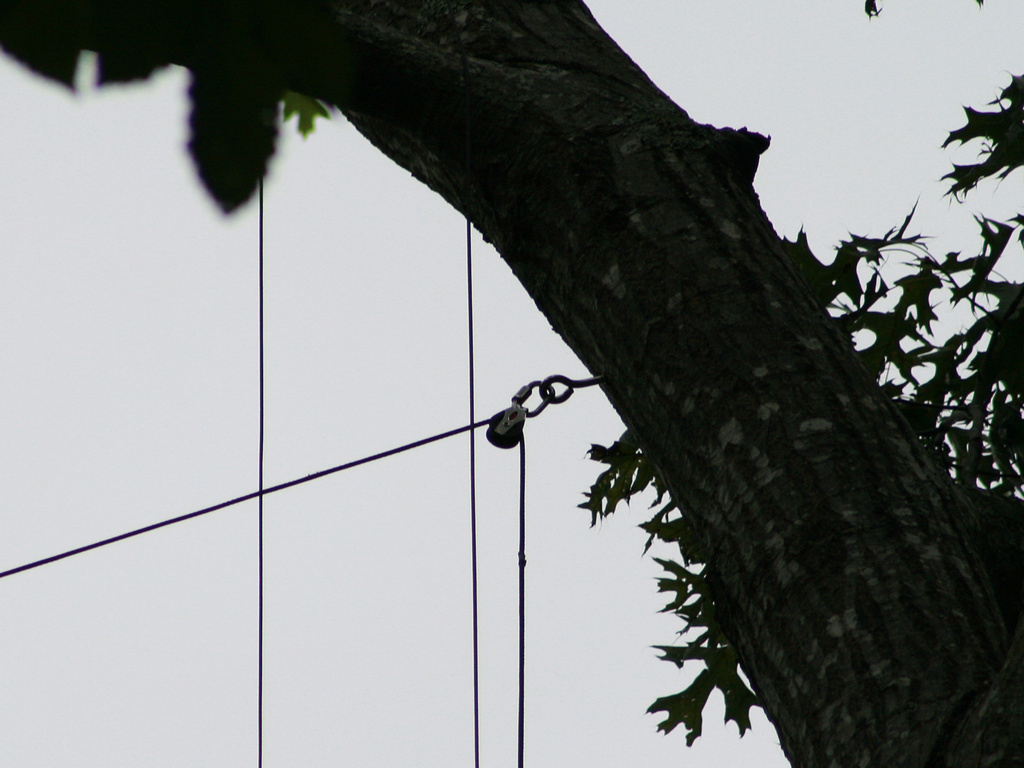
I estimate that the screw eye installation shown above will last at least another three to five years before the trunk starts to subsume the eye. If not backed out of the wood by that point, it could be another five years or more before the tree starts to engulf the pulley as well. You can buy more time by using a screw eye having a longer shank and leaving more shank exposed between the bark and the eye.
The following photos show a similar re-installation; this pulley is about 10 ft high and supports one end of the 80 m dipole.
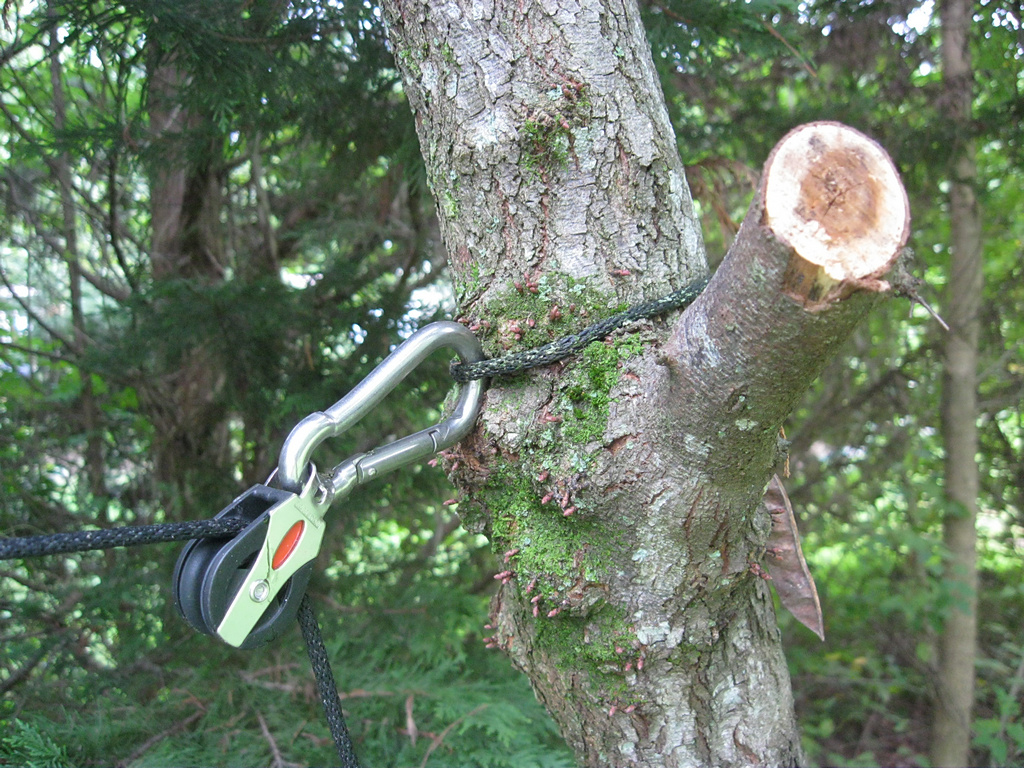
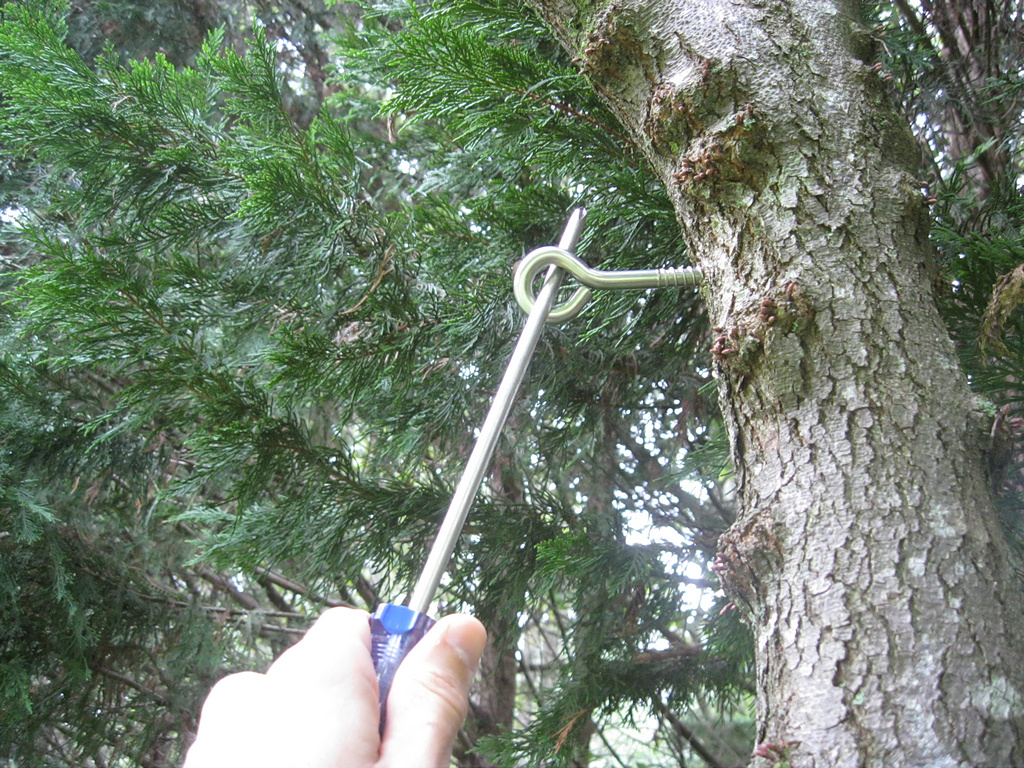
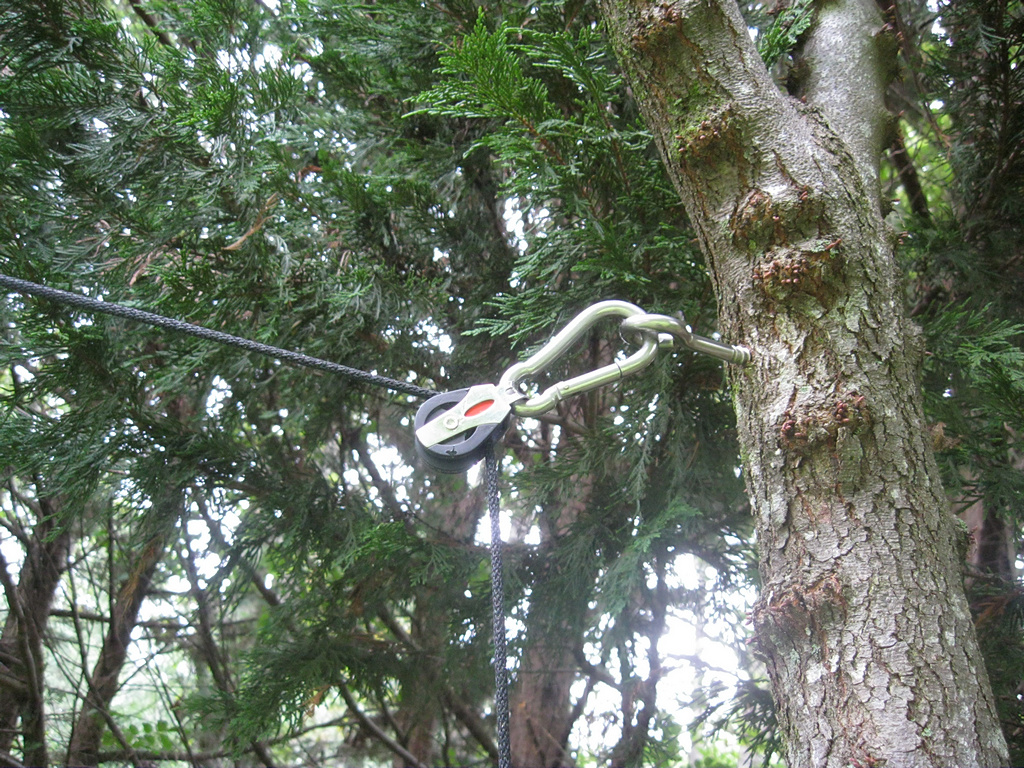
Go Ahead, Be a Block Head
If passing a rope, wire or cable around a tree trunk is unavoidable, I advise protecting both the rope and tree with wood or plastic blocks placed around the trunk.
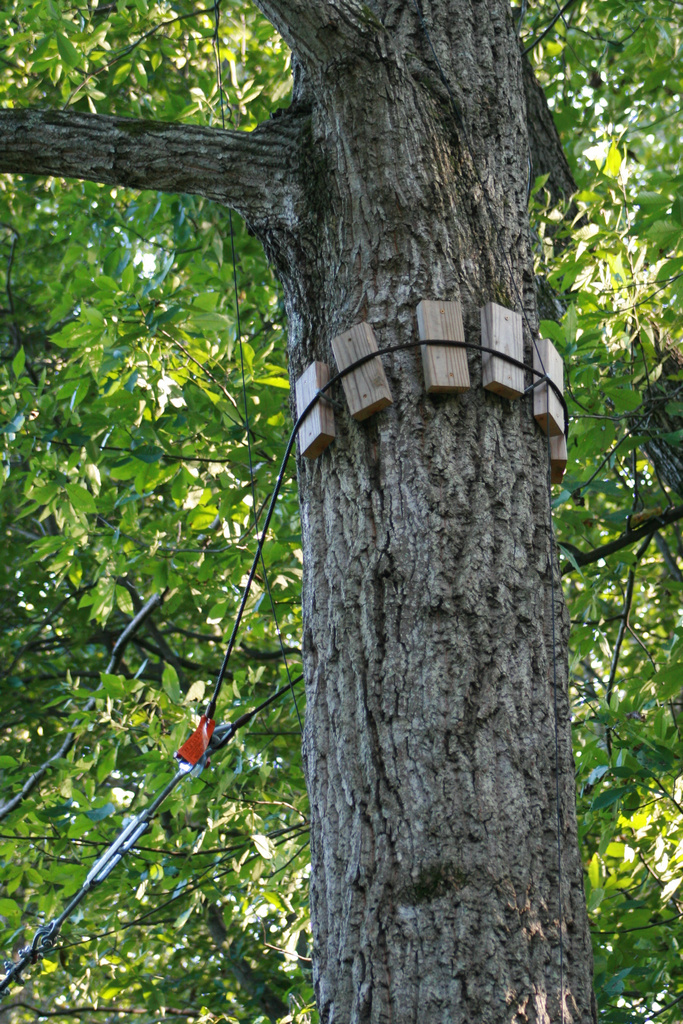
The above photo shows one end of a zip line which I built from 3/8 inch steel cable. The force on the cable exceeds what I want to entrust to a screw eye in wood — hence the wrap-around anchoring method.
The treated wood blocks, 2 x 4 x 8 inch, distribute the force of the cable over a large area of bark, greatly reducing the pressure exerted on the vital growth layers beneath. As this tree grows, the section of cable around the trunk will eventually need to be lengthened, but the tree won’t be damaged, nor will the cable be subsumed into the trunk.
Put Your Cleats On
I usually tie off the tail end of my antenna support ropes to a cleat installed on a tree at chest height. Trunk growth must be dealt with here as well. Roughly every three years, I remove the cleat and re-install it on a fresh spot on the bark.
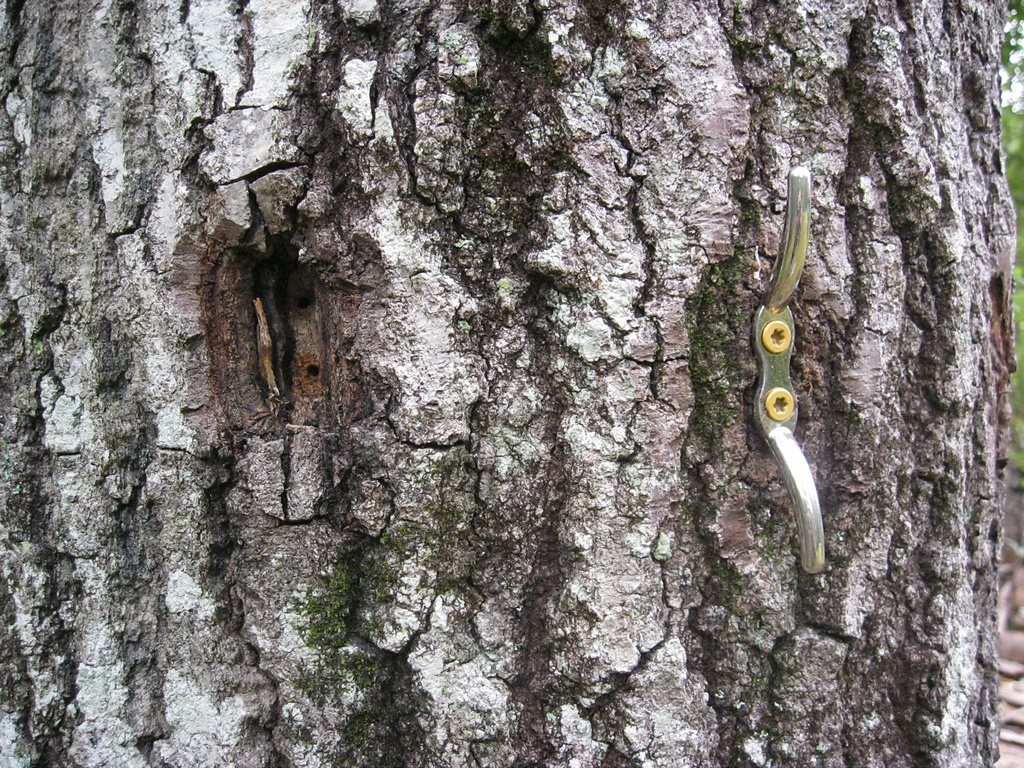
Obviously this practice prevents the tree from engulfing the cleat, but it mitigates a more subtle problem which I have experienced: the expanding wood of the trunk can break the horns off a rope cleat of this type. The wood gradually pushes the horn out, breaking it off at the screw. Naturally, the broken cleat no longer retains the rope and allows the antenna to fall. Hence, as a back-up measure, I install a screw eye to which the tail of rope is hitched after it is tied off on the cleat.
The style of rope cleat shown above (part no. 33805T53 from McMaster-Carr) isn’t the most robust, but they’re inexpensive, easily installed and removed, and grab the rope better than other types I’ve tried.
Stick It in a Fork
For most hams, pulley installation at significant height isn’t feasible. Instead, slingshots, air cannons, and bows and arrows are commonly used to shoot a light string over or into the canopy of a tree. The string is then used to haul up the antenna support rope, which then rests directly on small branches, limbs or in a fork.
In my experience, small branches don’t usually grow around a rope and freeze it in place. Perhaps this is due to swaying motion relative to the rope. The rope shown here, which holds up the author’s 40 m dipole, “floats” on numerous small branches.
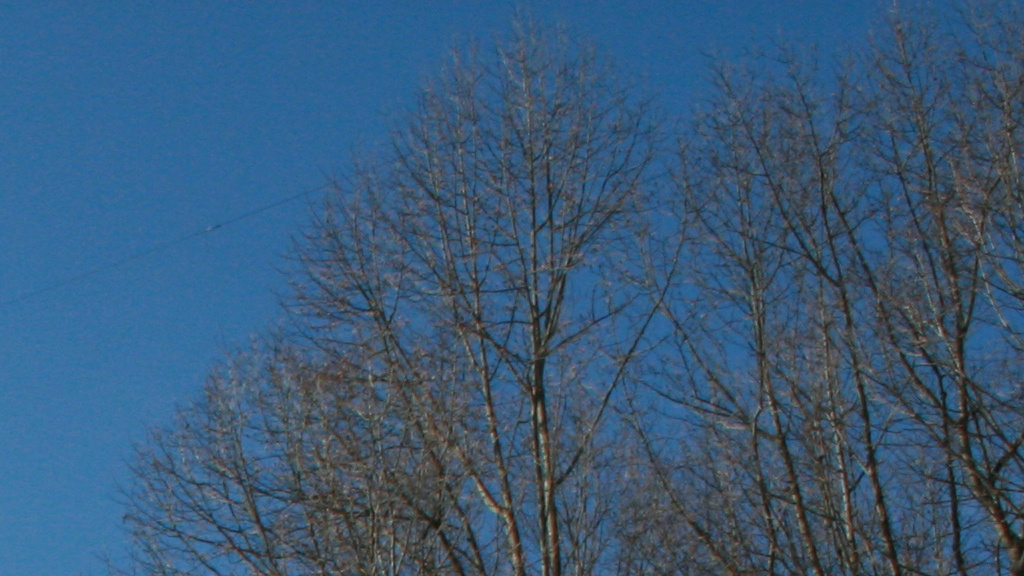
Larger limbs and forks, however, readily subsume a rope, preventing the antenna from being lowered. One can sometimes keep the rope running free by allowing it to slide through the fork or limb approximately every six months (this is also a good time to inspect the rope for damage – more on this below).
Another option is to pass the rope through a tubular object variously known as a cambium saver or rope sleeve. These can be homebrewed from flexible conduit or pipe, or purchased from arborist supply stores.
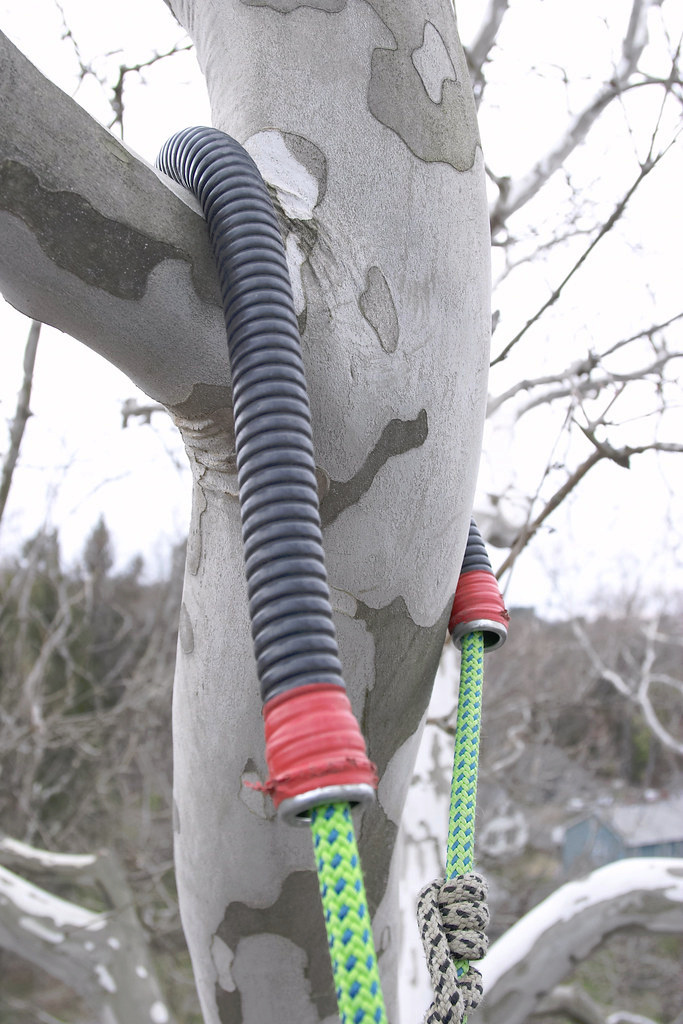
The rope sleeve can be installed from ground level by threading the rope through it, tying a slippery overhand knot (or larger stopper knot if necessary) behind the sleeve so that the rope pushes it up and into place as the rope is hauled over the fork. Once the sleeve is in place, the rope is tugged from both sides, causing the slippery knot to spill.
The inside diameter of the sleeve should be large enough that the rope can pass through it freely once the fork inevitably grows around and captures the sleeve. Replacing the rope after this happens can be done by joining the new rope to the old with a knot — if the knot will fit through the tube — or by temporarily “butt-splicing” the ropes with several wraps of electrical tape and hauling the new rope gently into place.
Are You A-Frayed of This Rope?
Ropes that are supported by direct contact with a tree (as opposed to running through a pulley) are subject to abrasion damage as a result of the tree moving in the wind relative to the rope. The only direct-on-tree cases where I have found abrasion minimal to non-existent are where a rope passes over a fork or stout limb of only one tree, and the tail of the rope is tied off to the trunk of the same tree. In such cases, the tree and the rope sway in unison, minimizing friction.
Ropes at risk of abrasion should be lowered periodically for inspection. In my experience, every six months is a good interval to perform this check. The rope below was close to failure when I pulled it down for inspection. A couple more weeks of friction, or a good pull in a heavy wind would have broken it and brought the attached dipole down.
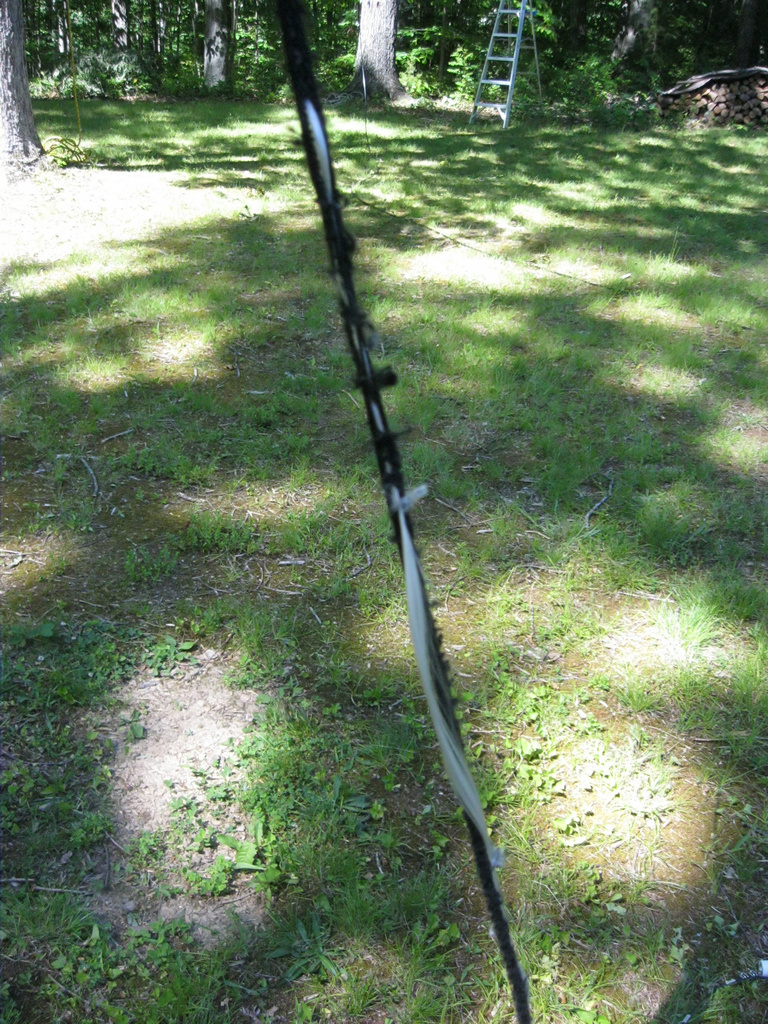
The most suitable type of rope for antenna support is black, braided polyester (trade name Dacron). It is strong, resists abrasion as well as can be expected, and is nearly impervious to UV degradation and moisture damage.
I usually use 3/16 inch diameter, single-braid rope in applications supported by a pulley. I generally try to use 1/4 inch single-braid when the rope is subject to abrasion against the tree, as the larger diameter lasts a bit longer. Double-braid polyester rope would offer better still abrasion resistance, but it’s significantly more expensive than single-braid.
Regardless of the diameter and construction of the rope, if it rubs against the tree that holds it up, it should be considered a consumable material and will have to be replaced eventually.